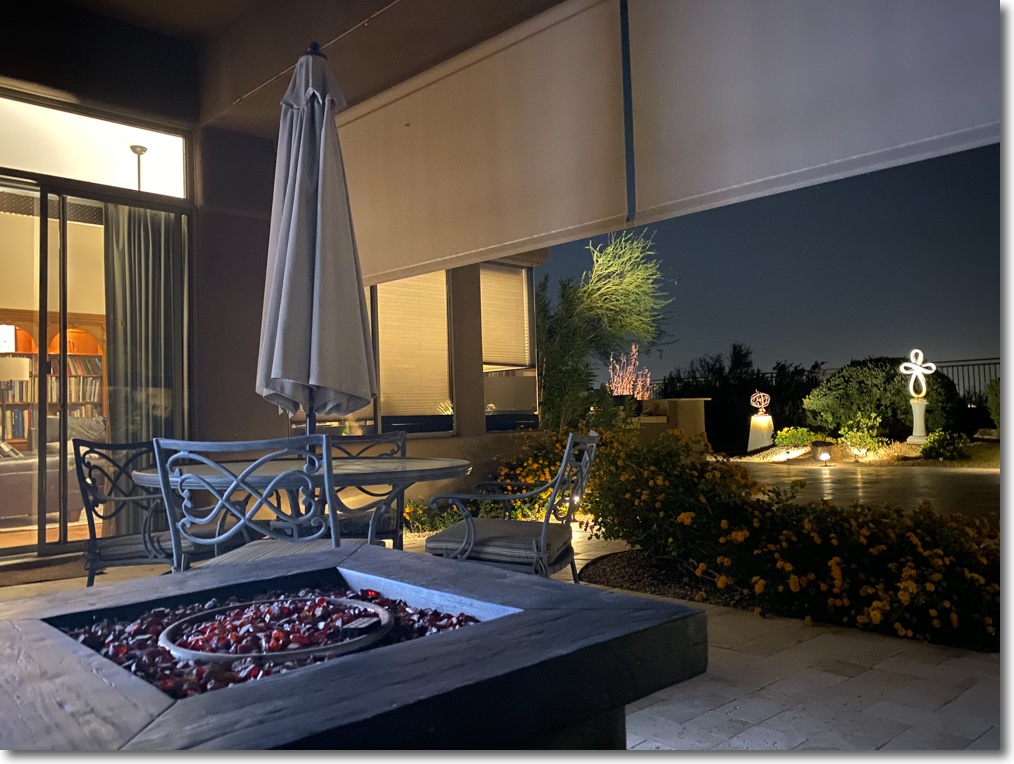Control of dynamic range and Night Mode.
Click here for an index of all iPhone articles.
Here’s an index of the iPhone 11 Pro pieces:
Part I – The revolution realized
Part II – Upgrading
Part III – The ultrawide lens
Part IV – The Normal lens
Part V – The Telephoto lens
Part VI – The Focos app
Part VII – Quirks and anomalies
Part VIII – HDR and the Night Mode
Part IX – The digital zoom function
Part X – A lens correction profile for the ultrawide optic

Outstanding results, no user input required.
This image, snapped handheld on my patio the other night, is of a subject with extreme dynamic range. The firepit and flowerbeds were in pitch darkness, but the iPhone 11 Pro came through, automatically switching to Night Mode. Unlike with the iPhone 7, HDR is not a switchable option. It’s working all the time – as it should be – and the superb Night Mode kicks in invisibly when needed. The image is straight out of the iPhone camera, absent a small crop to restore verticals. The cameras actually takes some 5 seconds to record nine images, with the CPU selecting the best bits for the final result. A moving indicator on the left of the screen reminds you to be patient. Note that Night Mode is not available when using the 0.5X lens; it’s automatically invoked in poor light with the 1X and 2X lenses. There are no stitching or digital artifacts visible.
Lightroom reports the exposure as 0.5 seconds at f/1.8, and the iPhone has cranked up the ISO to 800. Though the snap was made handheld, the details are tack sharp with grain barely visible in 1:1 pixel peeping on screen. That means a 30″ wide print. Further, an outstanding job has been done of color rendering, from the warm interior of the sitting room, to the white light on the love cross.
The only way to obtain a like image with big digital gear would be to take multiple images for HDR layering using a tripod, and applying extensive post processing labor. The post processing labor involved here was exactly zero, which can only ever be a good thing. Spending time at a computer display trying to make your poor pictures look better is time wasted. For me HC-B is the exemplar here. He never processed a single roll of film or printed an image. He had a back office functionary execute these mundane tasks, applying fungible skills, ones which could be executed by thousands of like operators. His time was better spent taking pictures. The dynamic range processing in the iPhone 11 provides that functionary at no extra charge.
There are many reasons to like the iPhone 11 but I’m learning that control of dynamic range may be the most important one for photographers.
Here are the EXIF data for that snap (GPS location hidden):

Note that the file is a mere 2.24mB in size, making Lightroom behave once more like a spring chicken. It is a JPG not RAW, and remains tack sharp at huge enlargements, virtually grain free. Data selection and computational photography are at work here. For reference, a 14mp RAW file from my (sold) Panasonic GX7 MFT camera saved as a TIFF/PSD/DNG or whatever uncompressed format you favor, balloons to 42mp. The 50mp sensor in a gigantic DSLR generates a 150mp (150mp!) uncompressed file which needs a faster computer and more hard drive storage to load in a reasonable time. And you will need to combine several of those files for one HDR image. I’ll take the iPhone’s 2mB over the DSLR’s terabyte (500 times larger) any day.